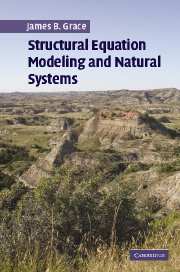Book contents
- Frontmatter
- Contents
- Preface
- Acknowledgments
- PART I A BEGINNING
- 1 Introduction
- 2 An example model with observed variables
- PART II BASIC PRINCIPLES OF STRUCTURAL EQUATION MODELING
- PART III ADVANCED TOPICS
- PART IV APPLICATIONS AND ILLUSTRATIONS
- PART V THE IMPLICATIONS OF STRUCTURAL EQUATION MODELING FOR THE STUDY OF NATURAL SYSTEMS
- Appendix I Example analyses
- References
- Index
1 - Introduction
Published online by Cambridge University Press: 04 December 2009
- Frontmatter
- Contents
- Preface
- Acknowledgments
- PART I A BEGINNING
- 1 Introduction
- 2 An example model with observed variables
- PART II BASIC PRINCIPLES OF STRUCTURAL EQUATION MODELING
- PART III ADVANCED TOPICS
- PART IV APPLICATIONS AND ILLUSTRATIONS
- PART V THE IMPLICATIONS OF STRUCTURAL EQUATION MODELING FOR THE STUDY OF NATURAL SYSTEMS
- Appendix I Example analyses
- References
- Index
Summary
The purpose and organization of this book
Structural equation modeling (SEM) represents both a different way of analyzing data, and a different way of doing science. A major theme of this book is that one of the factors that has limited the advance of ecological science has been the absence of methods for developing and evaluating multivariate theories. Understanding systems requires the capacity to examine simultaneous influences and responses. Conventional univariate analyses are typically limited to the examination of a single or at most a few processes at a time. Further, as will be illustrated in this book, characterizing interacting systems using univariate methods is commonly misleading and often inadequate. As I will argue in the final section of the book, conventional univariate hypothesis testing propagates a reliance on “theories of pieces” where one or two interacting processes are presumed to explain major characteristics of natural systems. Single-factor hypotheses seldom provide an adequate representation of system behavior. Worse still, such hypotheses are unable to be placed into a broader context or to evolve into more complex theories, regardless of the empirical evidence. Many of the simplistic theories that have occupied ecologists for so long seem irrelevant when we are faced with the task of predicting the responses of natural systems to environmental change. I believe ecologists have remained focused on univariate questions because we have lacked the scientific tools to ask and answer more complex questions.
- Type
- Chapter
- Information
- Structural Equation Modeling and Natural Systems , pp. 3 - 21Publisher: Cambridge University PressPrint publication year: 2006

